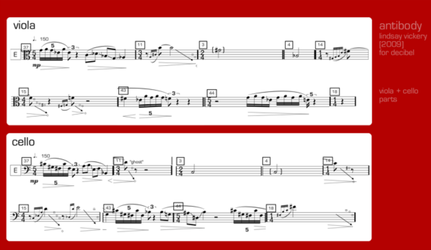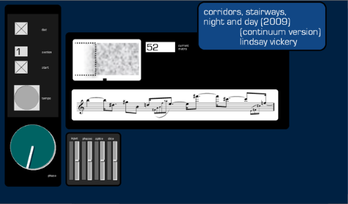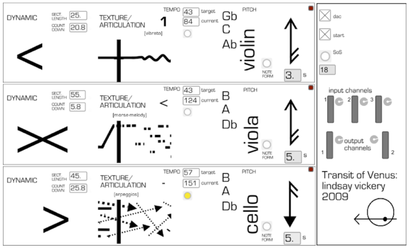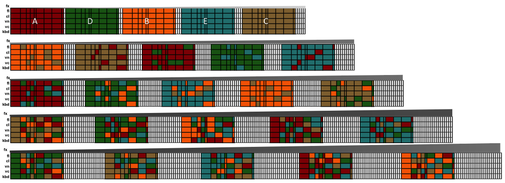2009
110 antibody [2009] alto flute, clarinet, viola, cello and electronics 10m

Antibody employs a permutative score to explore a formal structure based on the principle of mutation. Five musical cells, each nine measures long with a distinct tempo and texture, are subjected to “mutation” through the processes of deletion, duplication, insertion and translocation. Nine measures of the score, read from laptop, are presented to the performers in each cycle. At the end of each cycle there is a break (of increasing length) in which the measures are reassembled, creating increasingly diverse hybrid arrangements each time. In the first section of the work, the five cells are played in an order chosen algorithmically by the computer, but with each nine-measure span remaining unmodified. In the second section the five cells are performed again, but this time with some measures from the previous cell inserted.
|
In the subsequent sections the inserted measures are drawn from the two, three and finally four previous cells. By the final section the five cells have completely interpenetrated one another, as shown schematically it to the right. The contrasting, but proportionally related tempi of the five cells, (mm. 30, 60, 90, 120 and 150), mean that measures are performed at a new tempo when they are inserted into a different cell.
|
|
Each player is separately recorded and processed and the degree and rate of processing is increased throughout the duration of the work. The performers are synchronised in tempo by clicktracks sent via headphones. Three computers, displaying the scores for alto flute and clarinet, viola and cello and keyboard, are networked together to provide synchrony between the evolving scores.
The figure above shows a screenshot of the alto flute part. The translocation of the materials is indicated by the non-sequential bar numbers. |
As a consequence they are continuously transformed each time they are played. Between each cell is an open period, from four to twenty seconds, during which the performers are instructed to reflect upon these transformations through improvisation based on material they have just played. Digital processing of the acoustic instruments provides a final level of transformation.
|
Performances:
20091123 Decibel, SomAcoustica, Scale Variable, Callaway Auditorium UWA, Perth
20091123 Decibel, SomAcoustica, Scale Variable, Callaway Auditorium UWA, Perth
109 corridors, stairways, night and day [2009] bass clarinet and electronics 9m

In Éraflage’s “sibling” work, corridors, stairways, night and day, the exploration of different materials by the soloist evokes a journey through an imaginary space: the “corridors” and “stairways” of the title. This imaginary space is also (figuratively) in motion: revolving through figurative a “night” and a “day” state, depicted by changing cycles of effects processing. The work was inspired by Max Ernst’s painting Day and Night (1942), which portrays a nocturnal landscape strewn with windows (or canvases) depicting the same landscape in the daylight.
The performer is shown contrasting types of scored material. The continuum employed in Transit of Venus is interpreted by the performer to indicate an evolving range of improvised textures. Five varied forms of notated melodic material also appear at indeterminate times during the work. Audio from the live performance is processed throughout the work.
The performer is shown contrasting types of scored material. The continuum employed in Transit of Venus is interpreted by the performer to indicate an evolving range of improvised textures. Five varied forms of notated melodic material also appear at indeterminate times during the work. Audio from the live performance is processed throughout the work.
The audio processing completes one cycle through a period of harmonisation and pitch shifting (day), and reverbs and delays (night). The start-point in the cycle is varied for each performance. During the “reverbs and delays” processing cycle, samples of the static looping continuum from Éraflage, “phases of the night” are also played by the computer. Below is a schematic representation of the formal structure of corridors, stairways, night and day. Listen here.
|
Performances:
20090815 Lindsay Vickery, Artistry! Scale Variable, The Octagon, Perth |
|
108 transit of venus [2009] three melody instruments and electronics 9m

Transit of Venus utilises a nonlinear score, live sound processing and independent clicktracks to control a quasi-improvised performance by the players. In addition to following the tempo of their individual clicktrack, each player must also follow a mobile set of symbols that dictate the evolution of the dynamics, changes in the texture, the pitch class resources that they should use to realize the score, and finally the period of time over which these changes should occur. The textures indicated, are arranged in a developmental continuum from silence through to free improvisation as illustrated to the left. The intention here was to provide a clear developmental narrative contour, allowing for the permutations (in order and tempo) of each the independent part to be heard more clearly.
|
The tempi of the performers in Transit of Venus bear a number of different relationships: periods of relative independence from one another; periods where tempi converge; and others where they are brought into tempo unison. The graphical arrangement of the score-player for Transit of Venus atomises and separates the functions of the traditional score, where performance indications are normally unified vertically.
|
This configuration allows permutational independence to be established between parameters such as texture, pitch, dynamics and articulation. Each parameter is controlled in an asynchronous and nonlinear manner, creating the potential for a very large number of possible realisations of the work. In this way, the work’s configuration of information is only made possible through the computer medium.The work alternates between two principal modes. The first presents a scrolling continuum of musical textures (above). For example, if the performer is playing a single tone and receives the indication add vibrato, they should transition from the first texture to the second continuously over the indicated time-period.
The second is a free section during which the continuum and the metronomic click are suspended for all three performers. During these periods each performer follows the note-form indications, (shown right), that appear for short periods (between two and five seconds) on the right of the screen. |
Below is a notional representation of the structure of a performance of Transit of Venus, showing the independent order of texture continuum material presented to players and synchronous interruptions by free sections throughout the work. Transit of Venus is a nonlinear work, in that the tempo, and scroll-rate of the continuums is variable in each performance and each performer moves in and out of synchrony in relation to the other two.
|
Performances:
20090602 AXIS21, Honour Roll, Sound Spectrum ECU, Perth 20091110 Decibel, Tape it!, Totally Huge New Music 9, WAAPA Auditorium Perth 20130411 Decibel, Drawn from Sound, Spectrum Project Space ECU, Perth 20120203 Decibel, Australian Music, Theatre Capolla, Catania 20111124 Decibel, Tape It!, SWR Tage für Neue Musik, Stadthalle Biberach 20110117 Decibel, SomAcoustica, Logos, Ghent |
|







